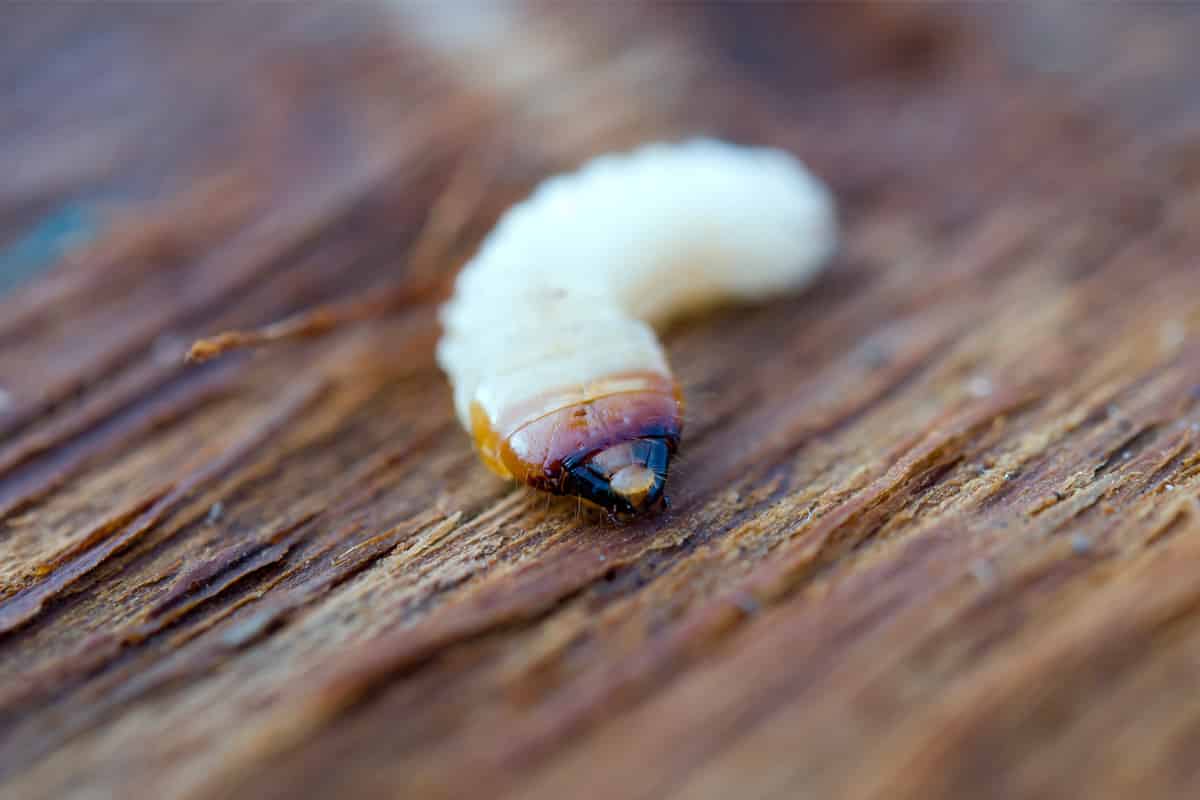Is it a Good Idea to Buy a House that You Know has Woodworm?
If you are looking to buy a house and it turns out to have woodworm then you’re likely to be asking yourself if it is really a good idea to buy a house with woodworm. Here’s some useful information about woodworm and how it affects buying a house.
Quick Links
- What is Woodworm?
- How Serious a Problem is Woodworm?
- How Can I Tell if a House Has Woodworm?
- Woodworm Surveys
- The Different Types of Woodworm
- Woodworm and Mortgages
- Woodworm and Home Insurance
- What To Do if a House Suffers From Woodworm
- How to Treat Woodworm
- Can You Treat Woodworm Yourself?
- Professional Treatment Services
- How to Avoid the Problem
- Cost of Treatment
- Is it a Good Idea to Buy a House with Woodworm?
What is Woodworm?
Many people are surprised to know that a woodworm isn’t a worm as such. Woodworm is a term used to describe the wood-eating larvae of one of a number of species of beetle.
Woodworm is not a species of beetle itself. Species of woodworm beetle include the Common Furniture Beetle (Anobium punctatum), Deathwatch Beetle (Xestobium rufovillosum), House Longhorn Beetle (Hylotrupes bajulus) and Powder Post Beetle (Lyctus brunneus).
A house can be affected by woodworm when woodworm beetles lay their eggs on the timber within the house. When the eggs hatch the larvae eat their way into the wood. They can spend several years in their larval form before developing into pupa, eating their way out of the wood and becoming beetles. The mature beetles then lay more eggs and the process repeats itself.

Access our selection of exclusive, high-yielding, off-market property deals and a personal consultant to guide you through your options.
How Serious a Problem is Woodworm?
A minor case of woodworm is not necessarily a serious immediate problem. It should still be investigated with a view to treating it within a reasonable period, however.
If left untreated woodworm can develop into a serious issue. Woodworm can infest doors, windows, skirting, joists, floorboards, rafters and other structural timbers. A severe case of woodworm can affect the structural integrity of a house. Although very rare, a severe case of woodworm could weaken roof timbers and floor timbers and cause a house to collapse.
Woodworm can affect sheds, garages and wooden furniture as well as well as the timber of a house itself.
Fortunately woodworm is not dangerous to humans or pets but the damp conditions woodworm thrives in can affect human and animal health.

How Can I Tell if a House Has Woodworm?
It is very difficult to tell if a house you are thinking of buying has woodworm, or how serious it might be – especially if you have no previous knowledge of woodworm. Many areas affected by woodworm will be in hidden, inaccessible places such as in roof spaces and under floors where they cannot be easily seen.
Where it is visible, a past or current woodworm infestation can be detected by the presence of small holes or flight holes, usually around 1-2mm in diameter, in the timber. There may also be what is known as frass or bore dust around the holes. Frass is woodworm waste and looks like very fine sawdust. Timber may also be weakened or spongy. Woodworm beetles may also be seen in the house, especially in the summer when they are most active.
The tell-tale signs of woodworm are slightly different depending on the particular woodworm beetle and type of timber.
Woodworm Surveys
Frequently neither the house seller (or vendor) nor the estate agent will know that a house has woodworm. So it is sensible to make your own checks.
If you have a home survey or building survey carried out on a property you wish to buy the surveyor will normally check for conditions that might encourage woodworm and signs of woodworm infestation. If they find any signs of woodworm they will note this down on the survey report.
A home survey will most likely not reveal the full details of a woodworm infestation. The surveyor may recommend that you have a more extensive woodworm survey carried out by a specialist. A woodworm survey will determine the nature and extent of the woodworm problem, make recommendations for treating it and repairing any damage that has been caused, and give an indication of the likely cost.
The Different Types of Woodworm
There are two types of woodworm infestation:
- Historic woodworm. With a historic woodworm infestation, there will be signs of timber damage, including flight holes, caused by the woodworm in the past. However, there will be no current woodworm activity.
- Active or live woodworm. With an active or live woodworm infestation larvae, eggs and/or beetles are present and active in or around the timber of the house. This is a more serious type of woodworm problem.
Bear in mind that if woodworm is affecting or has affected a house there may be other problems that have encouraged it in the first place. Structural faults, dampness, leaks, dry rot or wet rot are sometimes found alongside woodworm.
Woodworm and Mortgages
If woodworm has been found in a house you want to buy it could make getting a mortgage more difficult in some cases. Potentially a mortgage lender could decline to offer a mortgage because of woodworm.
Mortgage lenders such as banks and building societies are likely to make getting a woodworm infestation treated, and any related damage repaired, as a condition of granting a mortgage. They may withhold a portion of the mortgage until the woodworm and any other severe problems have been rectified and proof of woodworm treatment has been provided.
Woodworm and Home Insurance
Woodworm is not usually covered by house insurance policies. Therefore if you buy a house affected by woodworm you will not be able to claim for the cost of curing it or repairing any related damage.
What To Do if a House Suffers From Woodworm
The best advice is that you shouldn’t buy a house with a woodworm infestation unless you know the extent of it, what needs to be done to cure it, and what the cost will be.
There are several options open to you if you find out the house you want to buy has woodworm:
- Walk away, and look for a house that doesn’t have woodworm.
- Ask the seller to get the woodworm treated by a professional woodworm treatment expert and provide evidence the woodworm has been treated before the purchase goes through.
- Negotiate a price reduction with the seller to take account of the woodworm infestation and any related problems there might be. Find out what the cost of treating the woodworm will be first.
- Buy the house anyway and get the woodworm treated yourself. If you like the house, the purchase price is fair and you understand the extent of the woodworm problem and what it involves woodworm need not stop you from buying a house.
How to Treat Woodworm
Treating woodworm successfully involves four main stages:
- Identifying the parts of the house that are affected by woodworm. Remember that woodworm may exist in parts of a house that you cannot easily see or access, such as attics or lofts and underfloor areas. It may be necessary to remove floorboards or cladding to access all the affected areas.
- Killing the woodworm with a suitable insecticide or pesticide, assuming it is an active or live infestation.
- Repairing the damage that has been done by the woodworm. If the timber in your house has been severely damaged by woodworm it may need to be removed and replaced.
- Rectifying the conditions that could promote another woodworm infestation.
Can You Treat Woodworm Yourself?
It is possible to treat woodworm yourself in some cases. You can buy specialist woodworm sprays and solutions for a DIY treatment of woodworm. These are usually pesticides or insecticides containing permethrin. They work on active woodwork infestations including the eggs, larvae and adult beetles.
Another form of treatment is to block the flight holes and make them less attractive as a place for woodworm beetles to lay their eggs by painting or varnishing the timber.
Professional Treatment Services
Unless you are confident about treating the woodworm yourself you should use a pest control expert to kill the woodworm and prevent reinfestation.
Pest control experts will use professional chemical sprays and solutions either as surface or injection treatments to treat the woodworm. Fumigation may also be used to treat woodworm in inaccessible areas.
Electrical insect killers and flypapers may be used to kill the woodworm beetles, where they are found.
Non-chemical methods for treating woodworm include heat and freezing, which may be particularly suitable for furniture.
One important advantage of using a pest control expert to treat woodworm is that they will usually provide a guarantee for their work. Woodworm treatment experts often provide a guarantee of up to 30 years.
How to Avoid the Problem
Woodworm beetles and woodworm larvae are attracted to, and thrive in, damp or moist timber. You can reduce the risk of a woodworm infestation, or help prevent it recurring, by curing any damp issues in your house. Maintaining low humidity and a warm, well-ventilated property may help to avoid woodworm problems.
Cost of Treatment
It is difficult to know how much it is likely to cost to treat woodworm without knowing the extent of the problem. It is a good idea to obtain several quotes from woodworm specialists before buying a house that has woodworm.
As a very general guide using a pest control service to investigate and treat woodworm in an average sized house is likely to cost in the region of £500-£1,000.
Is it a Good Idea to Buy a House with Woodworm?
It can sometimes be a good idea to buy a house with woodworm, odd though it may seem!
Houses affected by woodworm may put off other buyers, so there may be less competition. The sellers of properties affected by woodworm may also be more willing to accept a lower offer. As the cost of treating and curing woodworm problems is not necessarily high a house with woodworm could turn out to be a good buy overall.
As long as you are aware of the extent of the woodworm, the cost of curing it, and are willing to take on the problem there is not necessarily any need to avoid buying a house with woodworm.
